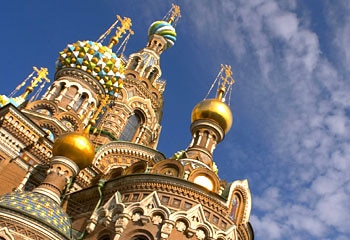St Petersburg's tsar turn
Life in St Petersburg is lived as if there's no tomorrow and, during mid-summer White Nights when the sun never sets, the city barely sleeps.

PROFLIGATE, battered and bruised – or fascinating and beautiful beyond belief. Which description best suits St Petersburg? The answer is both and all, for Peter the Great's city on the Neva is nothing if not wondrous, even in decaying splendour.
It is one of those cities that frequently tops must-visit lists, not just for its astounding architecture and overt displays of wealth, but because visitors come away knowing they have visited a city with a soul.
You don't even have to blast away the grime of a long Russian winter to find it.
Just walk around the side of the Church of the Saviour on the Spilled Blood, built by Tsar Alexander III on the spot where his father was assassinated in 1881, and see the shell damage left from the German army's siege of 1942 to 1944.
Or listen to Shostakovich's seventh symphony and reflect on the poignant scene at its first performance in the city during that siege. People were starving – dying in their hundreds of thousands – but they came in their rags, with their guns and gas masks, to listen and be nourished by the musical feast. Half the orchestra was dead, and instruments left on empty chairs were a silent memorial for the lost music.
Yes, St Petersburg – the 300-year-old city named after a saint – its gritty people and its sumptuous heritage, are survivors.
Life is lived as if there's no tomorrow, yet with half an eye on the past. Young brides and grooms in their wedding finery celebrate their union on Saturdays by visiting important memorials and buildings for their bridal photographs, before leaving flowers at the shrine of the Eternal Flame.
Streets swarm with people until all hours, shopping, nightclubbing, visiting bars, or swigging from liquor bottles. Young women totter along the pavements in high leather boots and the tallest stiletto heels; young men ogle their beauty and strut their own finery in a dance of the peacocks.
Along the broad main boulevard, the Nevsky Prospect, cars crawl, bumper to bumper, fumes bellowing from idling engines. And during the White Nights of mid-summer, when the sun never sets, St Petersburg never sleeps.
The city exudes excitement, and is anything but a museum. It's dynamic, a little edgy, with a shiver of menace. Conspicuous wealth, big cars, flashy jewellery and gorgeous women dressed to the hilt hint of Hollywood gangster movies. You can't help but wonder where the money's coming from.
Above all, if you're not in a large group getting the saccharine tour, you can really feel the city's energy and know you've travelled to somewhere exotic. Just getting there, unfortunately, tests your patience.
First there's the Trial By Visa at home. The paperwork is a killer, and the fee dreadful if you leave it to the last minute. Getting a specialist travel agent to do it for you is best.
Then there's the border check, a Cold War hangover.
We travelled to St Petersburg from Helsinki on the Sibelius, the modern Finnish day train, and saw the countryside change from neat farmhouses and cottages to neglect and poverty as we crossed the border.
Grim-faced guards, reminiscent of countless James Bond movies, board the train and disappear with your precious passport and visa for a worrying length of time.
And don't even think of going to the toilet or for a drink; the restaurant car and toilets are locked during the formalities.
On the Russian train back to Helsinki – the Repin – the train guard was a Lotte Lenya look-alike in a Rosa Klebb uniform and high-heeled boots. She was helpfulness personified compared to the border guards, who ask passengers to stand in the corridor while they search for possible stowaways.
But hedonistic St Petersburg never totally embraced the views of the earnest government in Moscow. Stalin and Lenin, after whom it was briefly renamed Leningrad, hated it with a passion and neglect of its grand buildings during the Soviet era was nearly as successful as the German barrage.
Great palaces are cracked and peeling; the once-vibrant gold, green or blue facades of many buildings are dull and dirty, waiting their turn for a clean; and the canals which give the city its soubriquet of Venice of the North have the same allure after a long winter as Venice's malodorous waters.
But, like Venice, St Petersburg transcends the grime. Political clout from favourite son President Vladimir Putin, money and painstaking restoration are returning the city to its former beauty.
Yet its soul never wavered: music, literature, great art and architecture thrive. St Petersburg nurtured, in various ways, the musical genius of Shostakovich, Stravinsky, Prokofiev, Rachmaninoff; the intellect of Pushkin and Dostoevsky; and the talent of its brilliant Kirov Ballet.
Even in death, St Petersburg's illustrious roll call claims Tchaikovsky, Borodin, Mussorgsky, Rimsky-Korsakov and Glinka, whose graves can be found in the Tikhvin Cemetery at the Nevsky Monastery.
Overlooking the Neva River is the palace complex against which all other buildings pale into insignificance: the Hermitage, the most glorious symbol of St Petersburg's grandeur.
It's now a museum with one of the greatest collections in the world; guide books say if you stand for only a minute in front of each item, you'd take 11 years to see it all. Believe it: touring even two galleries such as the Flemish and Dutch (40 Rubens, 24 Van Dycks, 40 Rembrandts...) is a full frontal attack on your senses. But neither gold nor riches could protect the tsars who built up this wealth.
Peter the Great's son, Alexei, whose torture was probably overseen by his own father, is buried under the stairs in the formidable Peter and Paul Fortress – it is said so Peter could walk on his grave.
Nicholas II, the last tsar, abdicated before his execution in 1918 and therefore died uncrowned. Technically unable to be buried next to his forebears in the royal burial chapel within the fortress, the bones of Nicolas and Alexandra, three of their five murdered children, three servants and the family doctor, are instead interred in a little alcove at the rear.
Simple wall plaques act as a roll call of the dead family, more poignant than any of the formal white marble tombs in the nave of the Saints Peter and Paul Cathedral. In late September, the remains of Nicholas II's mother, the Dowager Tsarina Maria Feodorovna (born Princess Dagmar of Denmark and sister of England's Queen Alexandra), are expected to be returned to Russia from Denmark where she lived in exile and was buried in 1928.
She will be laid to rest beside her husband, Alexander III, according to her last wishes.
Her interment will mark a further softening by the government towards the former royals and close another chapter in the history of this fascinating city.
The writer was a guest of MyPlanet and Scandinavian Airlines.



